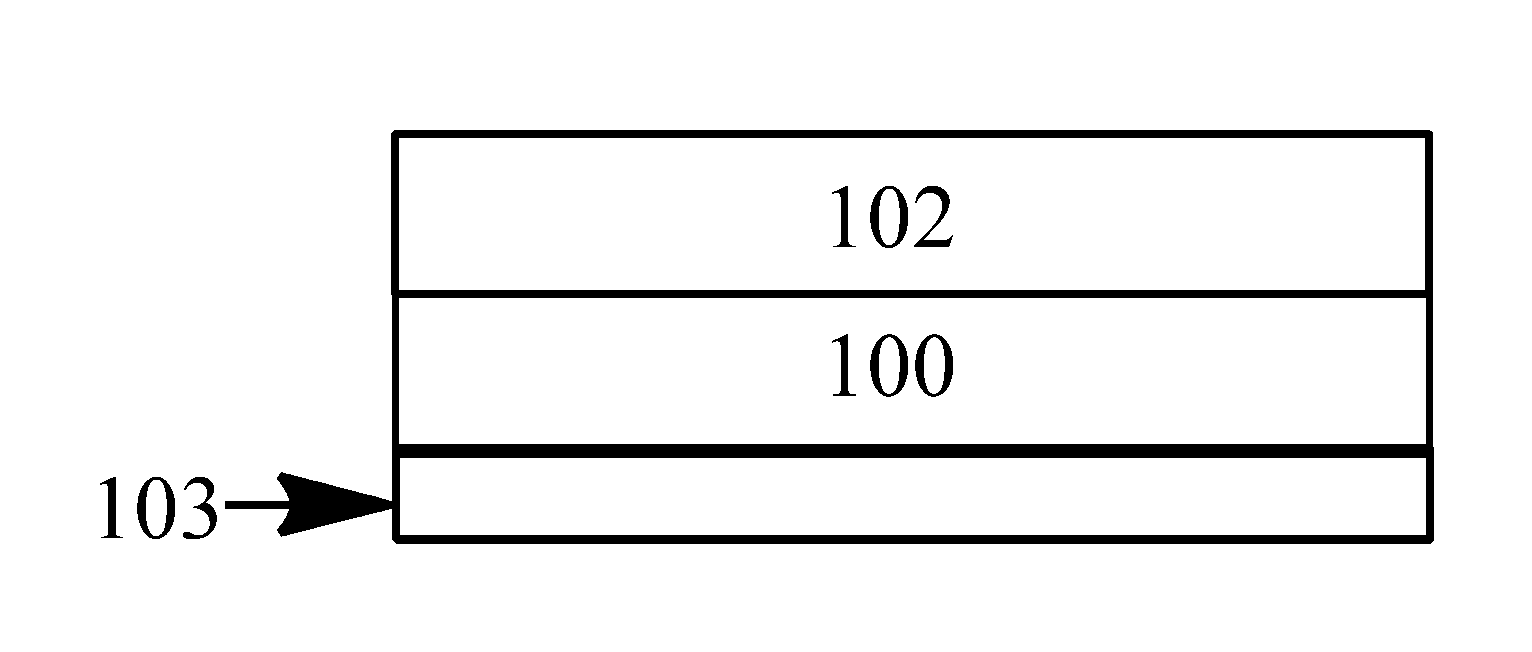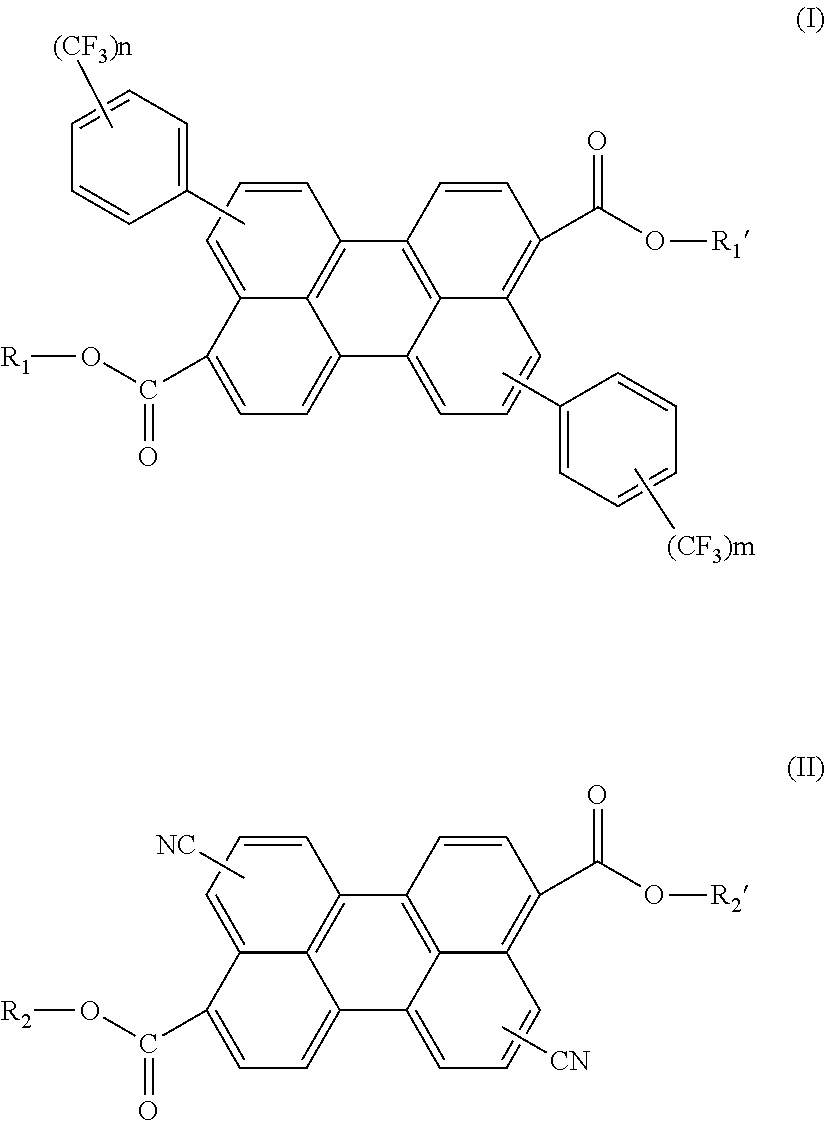Wavelength conversion perylene diester chromophores and luminescent films
a technology of perylene diester chromophores and wavelength conversion, which is applied in the field of wavelength conversion perylene diester chromophores and luminescent films, can solve the problems of ineffective utilization of the entire spectrum of light by photovoltaic devices, the inability to overcome many technical problems, and the inability to effectively utilize the entire spectrum of light, etc., to achieve good photostability, improve the photoelectric conversion efficiency of thin film solar cells, and enhance the effect of efficiency enhancemen
- Summary
- Abstract
- Description
- Claims
- Application Information
AI Technical Summary
Benefits of technology
Problems solved by technology
Method used
Image
Examples
example 1
Synthesis of diisobutyl 4,10-bis(4-(trifluoromethyl)phenyl)perylene-3,9-dicarboxylate
a) Step-1
[0059]
[0060]To synthesize diisobutyl 4,10-dibromoperylene-3,9-dicarboxylate (“Compound 1”), N-bromosuccinimide (7.85 g, 44 mol) was added to a solution of perylenedicarboxylic acid diisobutyl ester, which can be purchased from Aldrich Chemical Co. Perylenedicarboxylic diisobutyl ester was also synthesized from the corresponding di-acid derivative by esterification with isobutyl alcohol in DMF (50 ml) under heat at 65° C. for 3 hours (until the initial suspension changes to a clear solution). After cooling, methanol (500 ml) was added to the stirred reaction mixture. Soon heavy precipitate was formed, which was separated by filtration, washed with small portion of cold methanol, and dried in a vacuum oven to give the above Compound 1 as a yellow solid, pure by 1H NMR (9.6 g, 78%).
b) Step 2
[0061]
[0062]To synthesize diisobutyl 4,10-bis(4-(trifluoromethyl)phenyl)perylene-3,9-dicarboxylate (“Com...
example-2
Synthesis of bis-(diphenylethyl) 4,10-dicyanoperylene-3,9-dicarboxylate
a) Step-1
[0063]
[0064]To synthesize Compound 3, perylenedicarboxylic acid diisobutyl ester (9.1 g, 20 mmol) was reacted with KOH (5.6 g, 100 mmol) in ethoxyethanol (100 ml) at reflux temperature overnight. After cooling, water (approx. 500 ml) was added and the solution was acidified with 6 M HCl to yield a red solid which was separated by filtration. The solid was washed with water and dried to give 6.2 g of highly insoluble solid (for TLC EA / MeOH solution was used). Reaction was monitored by TLC only (silica gel, Hex / EA 4:1) until no more of the starting material was detected.
b) Step-2
[0065]
[0066]To synthesize Compound 4, bis-(diphenylethyl) 4,10-dicyanoperylene-3,9-dicarboxylate, Compound 3 (2.0 g, 4.0 mmol) was dissolved in chloroform (30 ml). Thionyl chloride (1.2 ml, 16 mmol) was added followed by 5 drops of DMF. The reaction mixture was left at reflux temperature for one hour. A clear red solution was obtai...
example 3
Luminescent Medium
Preparation of a Organic Down-Shifting Luminescent Medium
[0070]The organic down-shifting luminescent medium, which comprises an optically transparent polymer matrix and at least one luminescent dye, was fabricated by (i) preparing a poly(methyl methacrylate) (PMMA) polymer solution by dissolving a PMMA powder (from Aldrich) in tetrachloroethylene (TCE) (from Aldrich) at a predetermined ratio of 20 wt %; (ii) preparing a luminescent dye containing a PMMA matrix by mixing the PMMA polymer solution with the synthesized diisobutyl 4,10-bis(4-(trifluoromethyl)phenyl)perylene-3,9-dicarboxylate (“Compound 2”) at a weight ratio (Compound 2 / PMMA) of about 0.5:99.5 to obtain a dye-containing polymer solution; (iii) forming the dye / polymer thin film by directly casting the dye-containing polymer solution onto a glass substrate, then heat treating the substrate from room temperature up to 100° C. in about 2 hours, then completely removing the remaining solvent by further vacuu...
PUM
| Property | Measurement | Unit |
|---|---|---|
| Thickness | aaaaa | aaaaa |
| Thickness | aaaaa | aaaaa |
| Thickness | aaaaa | aaaaa |
Abstract
Description
Claims
Application Information
 Login to View More
Login to View More - R&D
- Intellectual Property
- Life Sciences
- Materials
- Tech Scout
- Unparalleled Data Quality
- Higher Quality Content
- 60% Fewer Hallucinations
Browse by: Latest US Patents, China's latest patents, Technical Efficacy Thesaurus, Application Domain, Technology Topic, Popular Technical Reports.
© 2025 PatSnap. All rights reserved.Legal|Privacy policy|Modern Slavery Act Transparency Statement|Sitemap|About US| Contact US: help@patsnap.com



